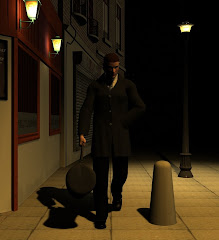Last week's episode, for example. This addressed one of my regular complaints – that the Tardis rarely bothers leaving Earth, or even London, anymore. Well, it kind of did. The strange planet it landed on was actually New Earth. Specifically, of course, New New York (or Really New York or something like that). It's a start, I suppose.
Incredibly New York, You Don't Get Newer Than This, has a problem, naturally. Remember all those clichéd sci-fi cities with rocket cars whizzing joyfully through the sky? Forget it here. The rocket cars are all stuck solid in a three dimensional subterranean gridlock. Whole lives can be spent travelling two miles on the motorway. Actually reaching your destination – well, that concept's so implausible that few even contemplate it. Instead the Promised Land has become the motorway fast lane where, legends say, you can almost reach 30 mph.
Unfortunately the legends also say that monsters live in the fast lane and these ones are true. Specifically, giant crab type things which live off the billowing clouds of exhaust fumes. It's not explained why they also attack cars but, well, they're monsters aren't they? And there's worst. There are no destinations any more. All of New Earth has been wiped out by a mutant happy drug. The only power left is supplied by a giant head in a vase and his catwoman attendant. (And this is why I keep banging on about Doctor Who; I can't over-emphasise how much pleasure I got from writing those last two sentences.) All there's left is the motorway.
That's one of the great things about the series. It takes a fairly obvious piece of satire and then turns it on its head. The remnants of a civilisation survive precisely because they're in a permanent gridlock. The motorway has saved them. And, by extension, cars are good. Which other wannabe fashionable show would have the nerve to say that nowadays?
There's parts of it that are less good. Forty five minutes is still too short for a whole story. In particular I'd have liked to find more out about these people stuck permanently in their cars. Not why some were half-cats – a surreal touch better for its lack of explanation. But why they were all so patient. There was no cussing or honking of horns. They even broke off occasionally to sing hymns. It certainly distinguished them from the motorists of old New York. Or even, for that matter, Really Dead Old York.
I've also still got misgivings about David Tennant as the Doctor. At times he attempts Christopher Ecclestone's intensity, at others he goes for a Tom Baker-esque eccentricity. Really, though, he's just a slightly more interesting Peter Davison. And as it's biologically impossible to be less interesting than Peter Davison, that isn't saying much. Freema Agyeman, despite being remarkably attractive, isn't my favourite either. She's settled in quickly but only by making herself a Billie Piper clone. It seems that for the foreseeable future all of the Doctor's assistants will be bright, brassy Cockney girls; just as they always used to be simpering things only good for screaming.
Side issues, however. Doctors and their assistants come and go. The series will remain great as long as there's Russell T Davies' scripts, funny, inventive and never quite going where you expect. Plus, of course, giant heads in vases and their catwoman attendants.

